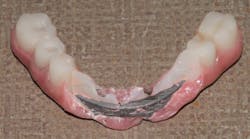Digital vs. analog in implant dentistry: Is the investment worth it—or just another cost?
For years, dentists have debated whether going fully digital in implant dentistry is worth the investment. CBCT scanners, intraoral scanners, 3D printing, guided implant surgery, and CAD/CAM milling systems all promise to improve workflow efficiency, precision, and patient experience.1
But is the financial investment in digital dentistry truly justified?
For implant dentists and practice owners, the real question isn’t about technology—it’s about profitability and patient commitment. Will investing in digital tools actually increase case acceptance, bring in more cash-paying patients, and reduce wasted chair time on price-sensitive leads? Or is it just another overhead cost cutting into an already expensive practice?
Let’s take a closer look.
The promise of digital dentistry: Efficiency, predictability, profit
There’s no doubt that digital technology has transformed the way implant dentists work. From initial diagnostics to final prosthesis delivery, digital workflows offer clear advantages.
Treatment planning is faster, with intraoral scans replacing messy impressions and eliminating long lab waits. Clinical precision improves through CBCT-guided surgery, which helps minimize placement errors and supports long-term implant success.2 Patients benefit from a more comfortable experience, as digital impressions are smoother and more engaging.
In-house restorations made possible through CAD/CAM and 3D printing allow for same-day crowns and more predictable results. And digital models can enhance case presentations, helping patients better understand and trust the proposed treatment plan.
The promise is compelling: improved efficiency, accuracy, and patient comfort. But does it solve the biggest challenges implant dentists face?
The reality: Digital alone won’t solve your biggest problems
While digital tools improve clinical workflows, they don’t automatically attract high-value patients or improve case acceptance rates.
The core issues that limit implant profitability are business-related—not technological.
Many implant dentists face a steady stream of price-sensitive leads. Research shows that cost, not access to digital technology, is the primary reason patients delay treatment.3 Consultations can be time-consuming, and many patients walk away after lengthy explanations.
Sticker shock, lack of urgency, and confusion around financing all contribute to slow case acceptance. Meanwhile, marketing costs remain high, and many practices spend valuable chair time on consultations that don’t convert.
Even advanced tools like intraoral scanners—which provide improved patient comfort, turnaround time. and cost-benefit ratio4—can’t prevent patients from saying, “I need to think about it.”
So what does move the needle on case acceptance?
What actually increases implant case acceptance?
The most successful implant dentists don’t rely solely on technology. They focus first on improving patient acquisition and education systems.
The real game-changer isn’t how high-tech your practice is—it’s how effectively you attract and convert qualified, cash-paying patients who are already prepared to say yes.
Here are five proven strategies.
1. Pre-educate patients before they even book a consultation
One of the top reasons patients walk away from implant treatment is lack of preparation. They don’t understand the cost or the process.
Many dentists spend hours explaining implants, only to see hesitant patients walk out. A structured pre-education system changes that.5
Online videos and educational content can prepare patients in advance. They should understand the differences between bridges, dentures, and implants before their consultation. Position implants as a long-term investment by showing cost comparisons with bridges over time.6 Presenting pricing in terms of monthly payments can also make treatment feel more attainable.
When patients arrive informed, they’re more confident and far less likely to object to price.
2. Position yourself as a specialist—not just another dentist offering implants
Patients are more likely to compare prices when they view implant services as a commodity. But when they see you as a specialist, price becomes less important.
Rather than saying, “We offer implants,” say: “We specialize in advanced, long-term tooth replacement for patients who want the best possible outcome.”
Your branding and marketing should reflect this expertise. Emphasize your focus on high-quality, personalized care and long-term results.
Patients trust specialists more than generalists—and that trust drives higher case acceptance.
3. Prequalify patients financially before the consultation
Implant dentists frequently express frustration about spending time on patients who can’t afford the treatment.
A financial pre-qualification system helps eliminate this issue.
Before booking a consultation, patients should:
-
Understand the general price range.
-
Be aware of available financing options.
-
Answer screening questions to ensure they’re serious.
This approach reduces wasted time and ensures you’re speaking with patients ready to move forward.
4. Sell the outcome, not the procedure
Patients aren’t motivated by technical details—they care about results. They want to smile confidently, eat without pain, and avoid the hassle of dentures.
Instead of focusing on the components of treatment, connect emotionally:
“Imagine enjoying your favorite foods without pain or discomfort.”
“Picture yourself smiling in photos without feeling self-conscious.”
“No more worrying about dentures slipping at dinner with friends.”
Emotions drive decisions. Focus on the transformation, not just the treatment steps.
5. Use digital tools to build trust—not just to impress
Digital dentistry is most effective when used as a trust-building asset.
Show patients their CBCT scans and let them visualize the process. These scans are now considered the gold standard for implant planning and help reinforce your credibility.7
Offer guided digital consultations that allow patients to see potential results before committing. Use technology to streamline and elevate the patient experience.
A smooth, high-tech workflow can reinforce trust and increase patient confidence in your practice.
The bottom line: Should you invest in digital?
If your goal is increased efficiency, clinical precision, and a smoother workflow, digital tools are absolutely worth the investment.
But if your goal is higher case acceptance and more cash-paying patients, digital tools alone won’t get you there.
First, invest in your marketing, patient education, and consultation processes. Better technology doesn’t guarantee more patients. A system that attracts, informs, and qualifies the right patients is what drives high-value implant cases.
Before spending six figures on equipment, ask yourself: Are your current systems converting? At the end of the day, a fully digital workflow means little if you’re still struggling to book profitable implant cases.
References
- Frąckiewicz W, Jankowska A, Machoy ME. CBCT and modern intraoral scanners as tools for developing comprehensive, interdisciplinary treatment plans. Adv Clin Exp Med. 2024;33(11):1267-1276. doi:10.17219/acem/175817.
- Tahmaseb A, Wu V, Wismeijer D, Coucke W, Evans C. The accuracy of static computer-aided implant surgery: a systematic review and meta-analysis. Clin Oral Implants Res. 2018;29(Suppl 16):416-435. doi:10.1111/clr.13346.
- Jayachandran S, Walmsley AD, Hill K. Challenges in dental implant provision and its management in general dental practice. J Dent. 2020;99:103414. doi:10.1016/j.jdent.2020.103414.
- García-Gil I, Cortés-Bretón-Brinkmann J, Jiménez-García J, Peláez-Rico J, Suárez-García MJ. Precision and practical usefulness of intraoral scanners in implant dentistry: a systematic literature review. J Clin Exp Dent. 2020;12(8):e784-e793. doi:10.4317/jced.57025.
- Bhagawati SB, Jain SR, Debnath P, Riyaz K, Patil R, Ansari J. Patients’ perceptions regarding acceptance of dental implants as an option for the replacement of missing teeth: an observational study. Cureus. 2024;16(3):e57232. doi:10.7759/cureus.57232.
- Carlsson GE. Dental occlusion: modern concepts and their application in implant prosthodontics. Odontology. 2009;97(1):8-17. doi:10.1007/s10266-008-0096-x.
- Deporter D, Dastgurdi ME, Rahmati A, Atenafu EG, Ketabi M. CBCT data relevant in treatment planning for immediate maxillary molar implant placement. J Adv Periodontol Implant Dent. 2021;13(2):49-55. doi:10.34172/japid.2021.016.
About the Author

Javeria Rameez Naqvi
Javeria Rameez Naqvi is an internet marketing expert, author, and entrepreneur who helps dental practice owners attract more high-value implant cases. With extensive experience in digital marketing, she specializes in strategies that bring in pre-qualified, ready-to-pay patients—without the struggle of chasing leads or price shoppers. You can reach out to her at [email protected].


